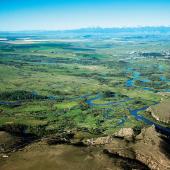Restoring the Whitebark Pine
When you look at the tree-covered mountains of Montana, you can’t help but notice patches of red scarring the green hillsides: these are whitebark pines, and they’re dying at an alarming rate. Our ecosystem needs this tree; the whitebark pine provides protein-rich seeds to many birds and mammals, and contributes to snow retention for a slower, more controlled spring runoff.
Thankfully, the Greater Yellowstone Coordinating Committee (GYCC) understands the importance of this tree and has devoted themselves to restoring the population to the Greater Yellowstone area. Over the past 13 years, the GYCC has been taking infection-resistant trees and evaluating their seedlings to find the tree with the highest resistance. From this seed source, the strongest 30 seedlings have been grafted onto potted rootstock, and this past spring, 440 blister-rust-resistant replicates were planted in a five-acre fenced area in the Little Bear Drainage southwest of Bozeman.
These genetically superior seedlings will begin producing their own blister rust-resistant cones in about five years. After several generations of seedlings, infection-resistant trees will be planted in the wild, spreading their resistant seeds to help restore the whitebark pine population—and in the process benefit the entire ecosystem. Check out the GYCC website for more information.













